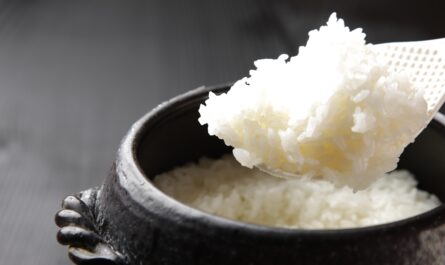Sushi is a beloved cuisine that has garnered fans worldwide due to its unique flavors and textures. However, for those who are gluten-sensitive or gluten-intolerant, traditional sushi rice might not always be the best option. Fortunately, there are numerous sushi rice alternatives gluten free that can equally satisfy your taste buds while keeping dietary restrictions in mind. Lets dive deep into understanding these alternatives and explore how they can add a twist to your sushi experience.

Understanding Traditional Sushi Rice
Traditional sushi rice, also known as short-grain rice, is a staple in Japanese cuisine. Its sticky texture and slight sweetness make it perfect for sushi. Typically cooked with vinegar, sugar, and salt, traditional sushi rice is generally gluten-free. However, issues arise when soy sauce or additional flavorings that contain gluten are introduced.
The Need for Gluten-Free Choices
With an increasing number of people adopting a gluten-free lifestyle due to health conditions like celiac disease or gluten intolerance, the demand for gluten-free alternatives has surged. While traditional sushi can often be modified to accommodate a gluten-free diet, integrating new ingredients can enhance the overall experience.
Introducing Quinoa as an Alternative
One of the most popular gluten-free sushi rice alternatives is quinoa. Known for its nutty flavor and remarkable nutritional profile, quinoa can provide a health boost to your sushi rolls. Quinoa is high in protein, fiber, and essential amino acids. For those interested in trying quinoa, check out this article on short-grain rice for more information.
Using Cauliflower Rice in Sushi
An innovative addition to the alternate sushi rice category is cauliflower rice. Not only is it a gluten-free option, but it is also low in carbohydrates and calories. Its an excellent choice for those following a ketogenic diet. The neutral flavor of cauliflower allows the taste of the other sushi ingredients to shine.
Exploring Brown Rice
For a more wholesome option, brown rice can be used in place of traditional white sushi rice. It maintains the sticky texture needed for sushi rolls while offering a higher fiber content and an earthy flavor. Many sushi enthusiasts are turning to brown rice for its health benefits compared to its polished white counterpart.
Exciting and Uncommon Alternatives
Black Rice: The Forbidden Delight
Also known as forbidden rice, black rice adds a splash of color and depth to sushi rolls. It is rich in antioxidants and offers a sweet, nutty taste. Besides being visually striking, black rice is packed with nutrients, making it a great gluten-free alternative.
Millet: An Ancient Grain
Millet is an ancient grain that can be used as an alternative to sushi rice. Its mild flavor and fluffy texture work well in sushi. Millet is also rich in magnesium and phosphorus, making it a nutritious option.
Amaranth: The Super Seed
Amaranth, often categorized as a pseudo-grain, can be an interesting choice for sushi rolls. Its slightly crunchy texture adds an exciting contrast to the soft filling inside the sushi. Amaranth is highly nutritional, offering proteins and minerals such as iron and calcium.
Experimenting with Other Grains
Polenta: Bringing the Italian Influence
For a creative twist, using polenta as a base for sushi is a delightful option. It is naturally gluten-free and provides a buttery, corny flavor. While not traditional, polenta sushi wraps offer a unique take on fusion cuisine.
Teff: The Ethiopian Touch
Teff is a staple grain in Ethiopian cuisine and can be a nutritious substitute for sushi rice. Its small grain size allows for a dense and hearty sushi roll. The flavor profile of teff is nutty and slightly sweet, which works harmoniously with sushi fillings.
Benefits of Going Gluten-Free
Choosing gluten-free sushi rice alternatives can offer multiple benefits, especially for those who are sensitive to gluten. These benefits include improved digestion, increased energy levels, and a reduction in gluten-related inflammation. Additionally, each alternative comes with its unique taste and nutritional advantage, allowing for a not only healthier but also more varied sushi experience.
Tips for Perfecting Sushi Rolls with Alternatives
Create your sushi rolls like a pro by visiting this article on soaking sushi rice. Experimentation and practice play a crucial role in achieving the perfect sushi rolls with gluten-free alternatives. Tips include adjusting the quantity of water used for cooking, experimenting with seasoning, and ensuring the grain or ingredient is adequately prepared to achieve the necessary sushi texture.
Where to Buy Gluten-Free Ingredients
Most of these gluten-free sushi rice alternatives can be found at local grocery stores or specialty health food stores. Additionally, for convenience, online platforms offer a wide range of options that can be delivered straight to your doorstep.
Incorporating Gluten-Free Sushi into Various Diets
Whether you are vegetarian, vegan, or following a paleo or keto diet, these gluten-free alternatives provide you with incredible flexibility to enjoy sushi in various dietary conditions.
Conclusion: Embrace the Variety
There are numerous tasty and nutritious sushi rice alternatives out there for everyone, especially for those needing a gluten-free option. These alternatives not only cater to dietary restrictions but also bring unique flavors and textures to the sushi table. Exploring these diverse options might just open your palate to new culinary adventures in the delightful world of sushi.

FAQs About Sushi Rice Alternatives
1. Is sushi rice naturally gluten-free?
Yes, traditional sushi rice is naturally gluten-free, but caution should be taken with added ingredients like soy sauce which often contains gluten.
2. What is the healthiest alternative to sushi rice?
Among the healthiest alternatives are quinoa and cauliflower rice due to their high nutritional content and versatility.
3. How can I make sushi gluten-free?
To ensure that your sushi is gluten-free, use gluten-free alternatives for the rice, choose gluten-free soy sauce, and double-check all additional ingredients used in the preparation.
This article contains affiliate links. We may earn a commission at no extra cost to you.



